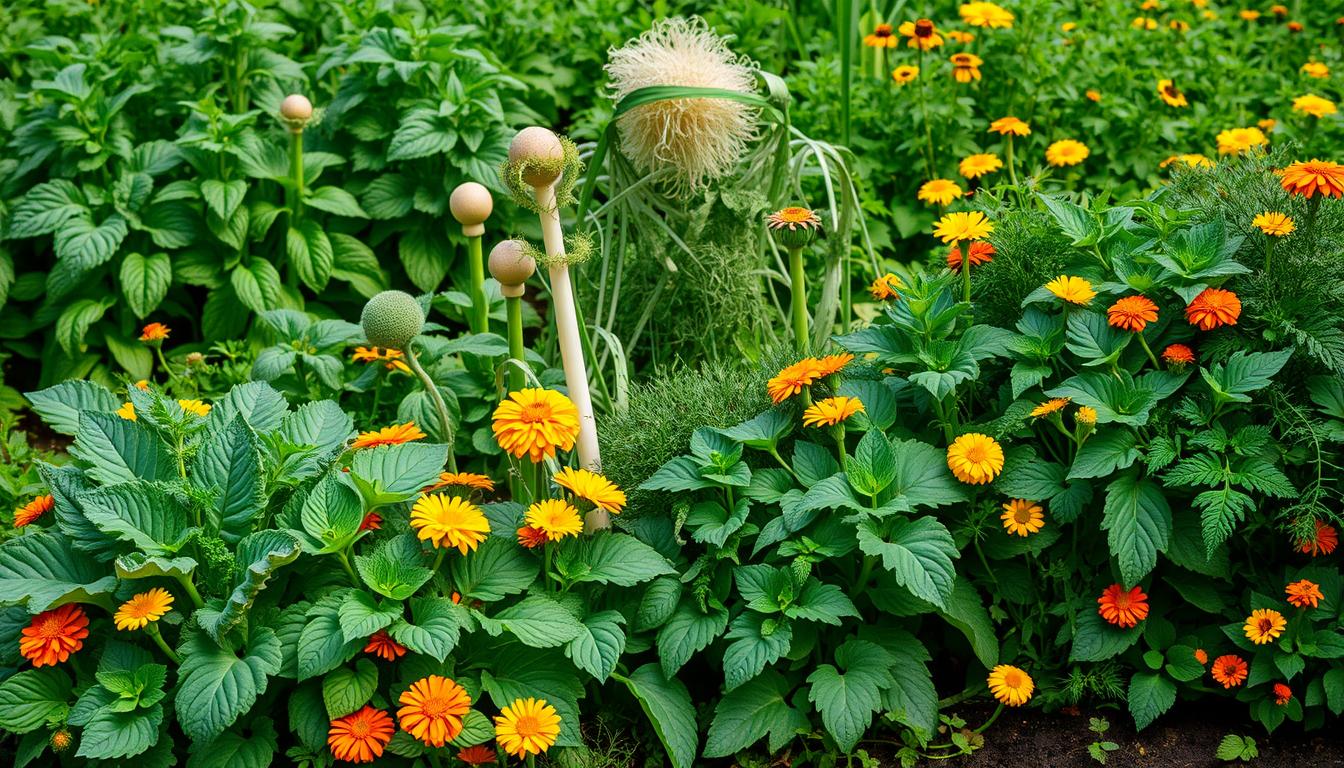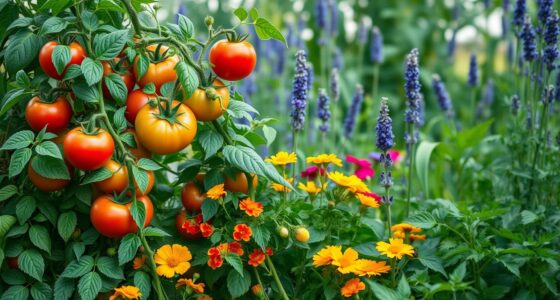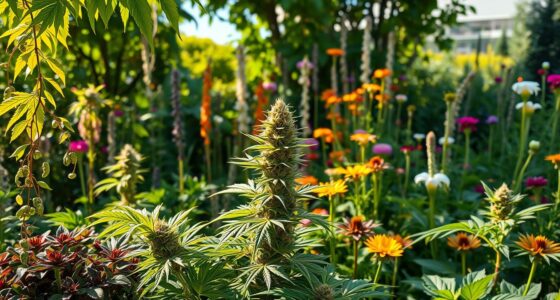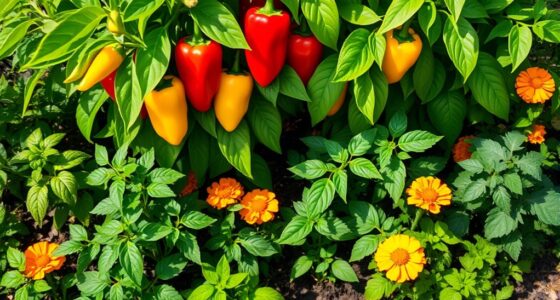Imagine stepping into your garden on a warm summer day, feeling the sun’s embrace as you breathe in the rich scent of fresh earth. Gardening is more than just a hobby; it’s a heartfelt endeavor that connects us to nature and nurtures our souls. When it comes to growing potatoes, the right companions can be the secret ingredient to transforming your garden into an oasis of productivity. In this guide, we’ll delve into the world of potato companion plants and how companion planting for potatoes can elevate not only their growth but also your gardening experience. Let’s discover the best plants to grow with potatoes and uncover the beauty of collaboration in the garden!
Key Takeaways
- Choosing the right potato companion plants boosts growth and flavor.
- Companion planting for potatoes helps manage pests naturally.
- Some plants, like beans and corn, thrive alongside potatoes.
- Herbs like basil and dill enhance pest control and attract good insects.
- A balanced ecosystem in your garden results in a more bountiful harvest.
Understanding Companion Planting
To make the most of your garden, you can explore the concept of companion planting. This technique involves carefully selecting plant combinations that thrive together, leading to healthier crops and improved soil quality. A companion planting guide provides insight into which plants work best in tandem, allowing you to reap the many companion plant benefits.
What is Companion Planting?
Companion planting is a gardening strategy that pairs different plant species to create an ecosystem where they can mutually benefit one another. This method relies on the idea that certain plants can enhance each other’s growth, deter pests, or even improve soil conditions when grown together. Understanding the principles of companion planting helps you cultivate a thriving garden environment.
Benefits of Companion Planting
The advantages of companion planting are numerous. Here are some key companion plant benefits to consider:
- Increased Yields: Planting complementary species can lead to improved crop production.
- Pest Management: Certain plants naturally repel pests and can protect their neighbors from infestations.
- Soil Health: Some plants enhance soil nutrients, particularly those that fix nitrogen, which is essential for growth.
- Efficient Use of Space: Companion planting allows for more effective utilization of garden space, leading to optimal growth.
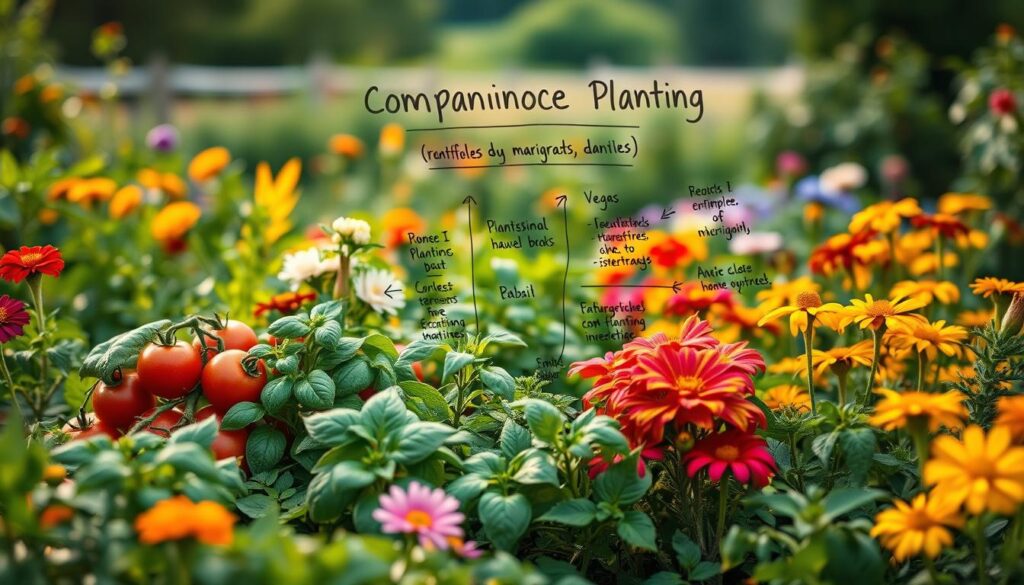
Incorporating companion planting into your gardening routine can transform your approach and yield impressive results. With thoughtful combinations, you can create not just a garden, but a healthy and sustainable ecosystem.
Why Potatoes Need Companions
Understanding why potatoes require companion plants offers insight into enhancing your gardening experience. Potatoes thrive best when surrounded by specific plants that provide essential nutrients and support their growth. Learning about plants that benefit potatoes helps you cultivate a healthier garden, leading to more abundant harvests.
Enhancing Growth and Flavor
Companion plants can have a significant impact on the growth and flavor of your potato crop. For instance, planting nitrogen-fixing legumes, like beans, can boost soil fertility by enriching it with vital nutrients. This improved nutrient supply contributes to stronger, tastier potatoes, showcasing the importance of following potato companion planting tips.
Pest Control and Prevention
Another crucial aspect of companion planting involves pest control. Certain plants naturally repel harmful pests that affect potatoes, including the notorious Colorado potato beetle. By carefully selecting companions, you can create a more resilient garden environment, ultimately reducing the need for chemical interventions and fostering a healthier growing experience.

Best Companion Plants for Potatoes
Finding the best plants to grow with potatoes can elevate your garden experience and yield a bountiful harvest. Combining vegetables and flowers wisely can foster nutrient-rich soil, support pest management, and enhance overall growth. Below are some excellent companions for your potato plants that will contribute positively to your garden.
Beans: A Perfect Match
Beans serve as a fantastic companion for potatoes due to their ability to fix nitrogen in the soil. This natural process enriches the nutrients available for potatoes. You can easily grow different varieties of beans alongside your potato plants, creating a harmonious garden ecosystem.
Corn: A Towering Ally
Corn provides essential vertical support for potato plants. This height not only shields low-growing potatoes from strong winds but also maximizes space in your garden. When you refer to your potato companion planting chart, you will find that corn’s stature and resource needs align well with potatoes.
Marigolds: Natural Pest Deterrents
These cheerful flowers are more than just a pretty addition to your garden. Marigolds emit a scent that repels harmful pests like nematodes, thus protecting your potato plants. Including marigolds among the best plants to grow with potatoes contributes to a healthier garden, free from many common pests.
Peas: Nutrient Partners
Peas function similarly to beans in that they fix nitrogen in the soil, enhancing soil fertility. Their growth habit complements potatoes, allowing them to share space without competition. With peas in your garden, you create a productive and nourishing environment for your potatoes to flourish.
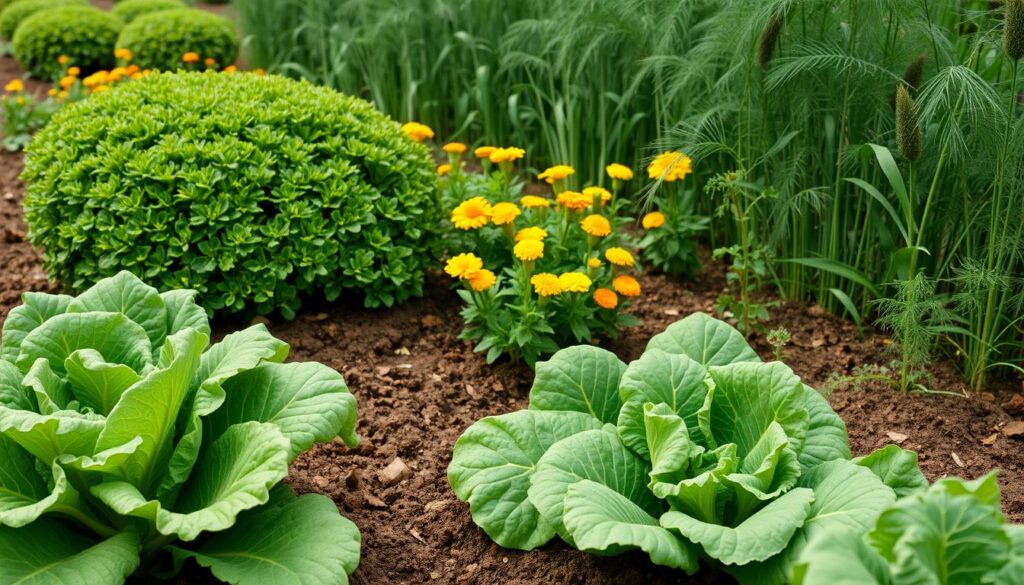
| Companion Plant | Benefit | Growing Conditions |
|---|---|---|
| Beans | Nitrogen fixing | Well-drained soil, full sun |
| Corn | Structural support | Rich soil, full sun |
| Marigolds | Pest repellent | Loamy soil, full sun |
| Peas | Nitrogen fixing | Rich soil, well-drained, full sun |
Herbs that Pair Well with Potatoes
Integrating herbs into your potato garden not only enhances flavor but also promotes a healthy ecosystem. Many herbs for potato companion planting serve dual purposes, such as pest control and attracting beneficial insects. Here are some standout options to consider.
Basil: Flavor and Pest Control
Basil brings a delightful flavor to potatoes and acts as a powerful pest repellent. This aromatic herb helps deter pests like thrips, ensuring that your potato plants remain healthy and productive. Additionally, you can enjoy fresh basil’s culinary uses as you harvest your potatoes.
Dill: Attracting Beneficial Insects
Dill is a fantastic choice in the realm of herbs for potato companion planting. Its tall, feathery foliage attracts beneficial insects such as ladybugs and lacewings, which feed on harmful pests. Planting dill near your potato crops can create a supportive environment that enhances overall plant health.
Oregano: Repelling Harmful Pests
This robust herb serves as a natural barrier against a range of pests that threaten potatoes. Oregano contains compounds that repel aphids and other harmful insects. Its strong scent not only protects your potatoes but also complements their flavor in various dishes.
| Herb | Benefits | Pest Control |
|---|---|---|
| Basil | Enhances flavor | Deters thrips |
| Dill | Attracts beneficial insects | Targets various harmful pests |
| Oregano | Repels unwanted insects | Fights aphids |
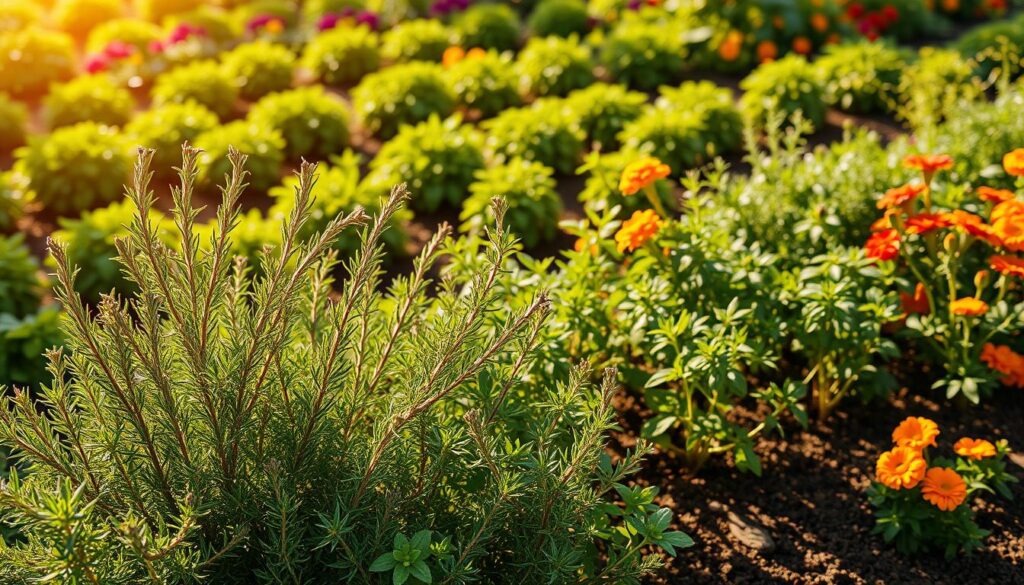
Vegetables that Thrive with Potatoes
Companion planting supports the health and productivity of your garden. Choosing the right vegetables that benefit potatoes can improve growth and deter pests. Certain companions, such as members of the cabbage family and onions, create a synergistic environment that enhances your potato crop. Let’s explore some ideal vegetables to plant alongside your potatoes.
Cabbage Family: Cabbage and Kale
The cabbage family, including cabbage and kale, works well with potatoes. These vegetables share similar growing conditions and occupy the garden space effectively without competing for roots. With their shallow root systems, they do not hinder the productivity of potatoes, allowing both to thrive together.
Brassicas: A Healthy Combination
Brassicas, which include broccoli and Brussels sprouts, form a beneficial alliance with potatoes. These vegetables that benefit potatoes enrich the soil with nutrients and are resilient when grown in proximity to potatoes. They can also help suppress weeds, giving your potato plants a better chance to flourish in a less competitive environment.
Onions: Boosting Flavor
Onions not only enhance the flavor of potatoes but also act as a deterrent to pests. By planting onions alongside your potatoes, you create a natural shield that protects both crops. This pairing of vegetables that benefit potatoes leads to a lush and productive garden space.
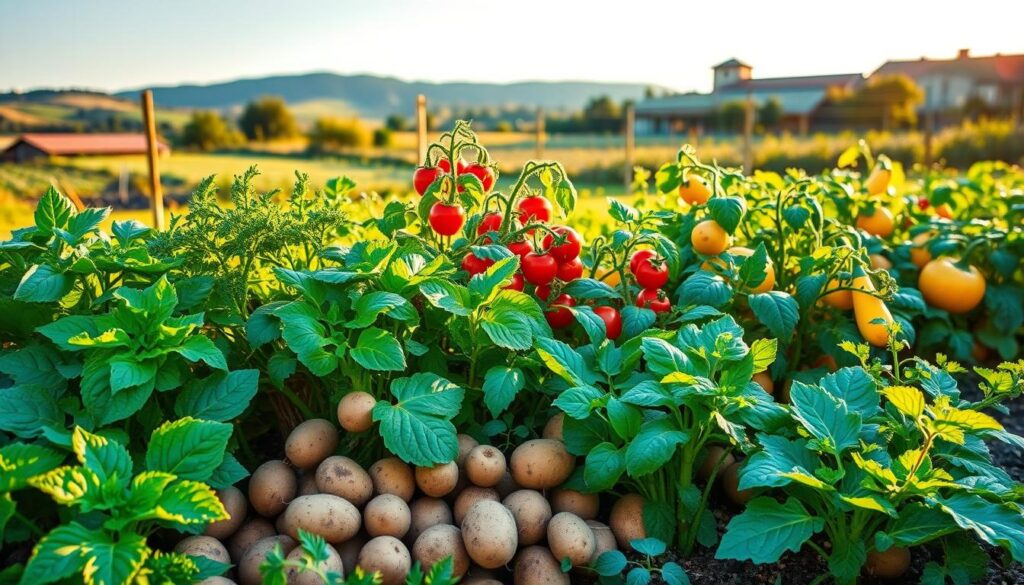
Flowers that Benefit Potato Gardens
Incorporating flowers for potato companion planting adds vibrancy and functionality to your garden. These floral companions not only beautify the space but also serve crucial roles in maintaining a healthy ecosystem for your potatoes. Here, we explore two standout flowers that thrive alongside potatoes, creating a beneficial relationship.
Nasturtiums: Attracting Pollinators
Nasturtiums act as magnets for beneficial pollinators such as bees and butterflies. Their bright colors and delightful aroma draw these essential insects to your garden, which is vital for pollination. Additionally, nasturtiums help repel aphids, keeping your potato plants healthier. Including nasturtiums as part of your flowers for potato companion planting can enhance both pollination and pest control.
Borage: Enhancing Soil Health
Borage contributes significantly to garden vitality by improving soil health. This flower fixes nitrogen in the soil, making it more nutrient-rich and accessible for potato plants. Borage also attracts beneficial insects like hoverflies, which prey on common pests, further supporting your potato crop. By adding borage to your flowers for potato companion planting, you create a conducive environment for optimal potato growth.
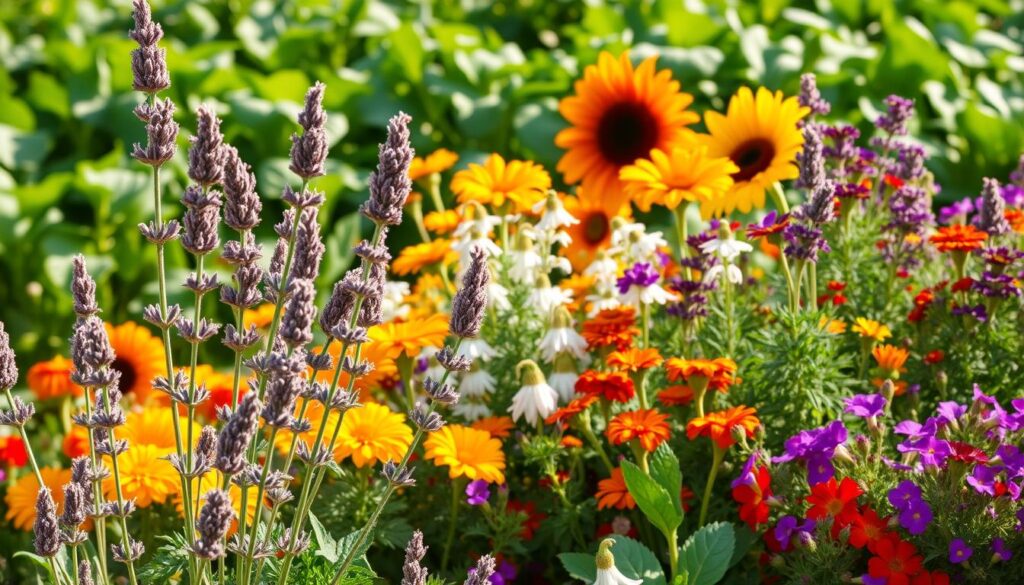
Plants to Avoid Near Potatoes
When planning your garden, certain plants to avoid with potatoes are crucial for ensuring healthy growth and maximizing yield. Awareness of which plants can compete for resources or introduce pests can make a significant difference in your potato crop’s success.
Avoiding Competition for Nutrients
Potatoes thrive when they have ample access to nutrients and space. Some plants can outcompete potatoes for essential nutrients, stunting their growth. It’s wise to steer clear of:
- Other nightshades like tomatoes, peppers, and eggplants.
- Root vegetables such as carrots, beets, and radishes.
- Cucumbers, which can take over valuable real estate in your garden.
Toxic Relationships: What to Skip
Aside from competition, certain plants can also lead to toxic relationships in the garden. These connections can introduce diseases that harm potatoes. Keep your potato bed healthy by avoiding:
- Sunflowers, which can harbor pests.
- Fennel, known to stunt the growth of potatoes.
- Mint, which can be invasive and compete aggressively.
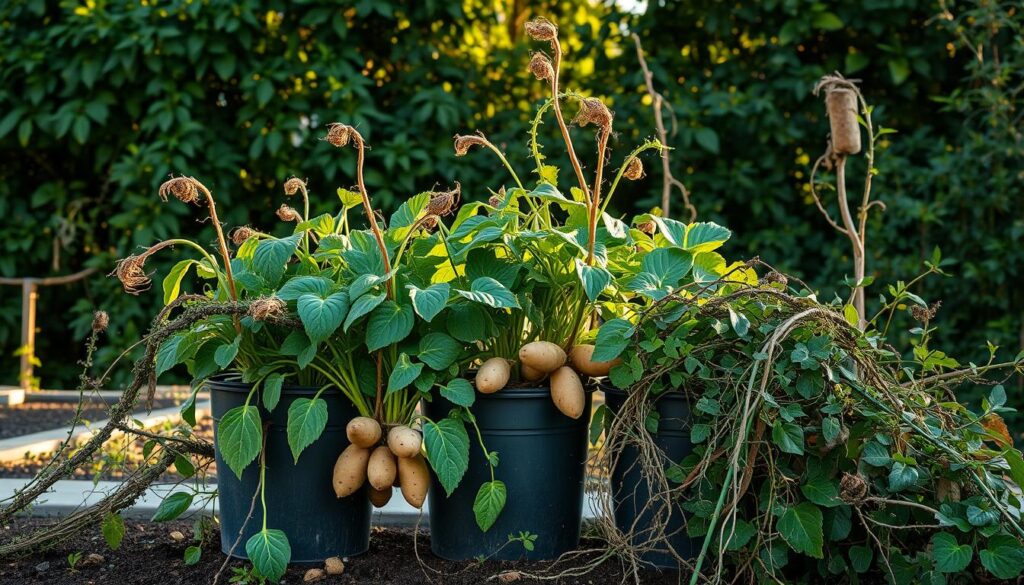
By being aware of the plants to avoid with potatoes, you can create a more robust and thriving garden, ensuring your potato crop has the best chance for success. Careful planning can yield a bountiful harvest while minimizing potential problems.
Timing and Spacing for Companion Plants
Understanding the right timing and spacing for your potato garden is essential for successful growth. Effective potato companion planting tips highlight the importance of a well-planned planting schedule. In spring, after the last frost, is the ideal time to plant seed potatoes. This allows your potatoes to flourish without the risk of cold damage. To achieve harmony in your garden, ensure that companion plants are seeded according to their growth cycles, preventing any interference with potato development.
Planting Schedule Considerations
When developing your planting schedule, consider the following:
- Seed potatoes typically need to be planted in early spring.
- Companion plants such as beans and peas can be sown around the same time.
- Utilize a staggered planting approach for fast-growing companions to avoid overcrowding.
Optimal Spacing for Companions
Spacings play a vital role in ensuring that all plants receive enough sunlight and nutrients. Follow these guidelines:
- Maintain at least 12 inches of space between potato plants to allow for adequate growth.
- Space companion plants like marigolds and herbs about 6 to 12 inches from potatoes to minimize competition.
- Consider vertical growth patterns of certain companions to maximize garden space while maintaining sufficient sunlight exposure.
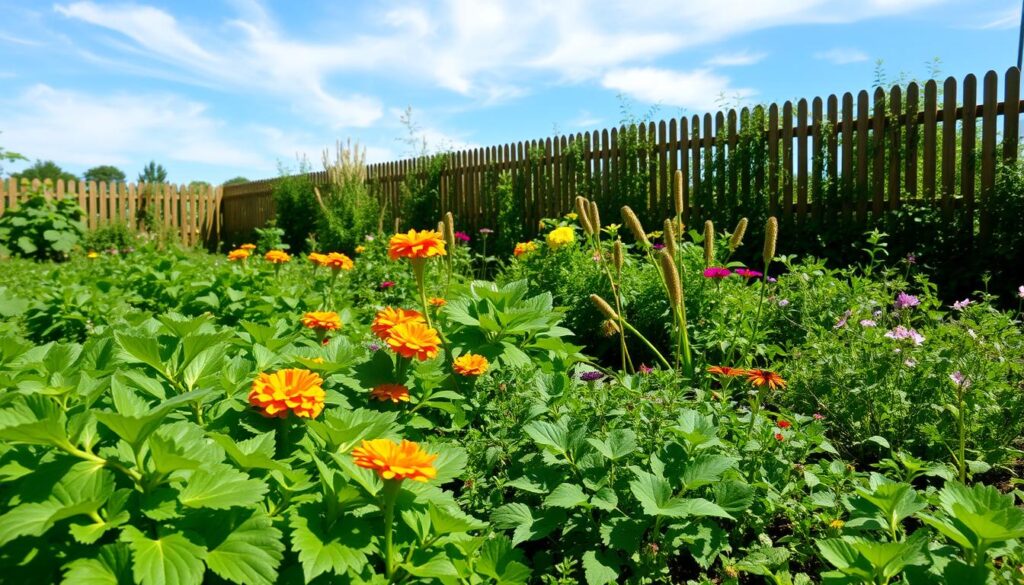
Managing Soil Health for Potatoes
Healthy soil plays a crucial role in the successful cultivation of potatoes. Understanding the specific nutrient requirements is imperative for achieving optimal growth. Potatoes have a significant demand for macronutrients, particularly nitrogen, phosphorus, and potassium. Adequate nutrient management contributes directly to plant vitality, yield, and overall quality.
Nutrient Requirements
To promote robust growth, you must ensure that your soil is well-balanced in essential nutrients. This involves testing your soil to determine nutrient levels. Once you identify deficiencies, strategize on amendments such as fertilizers or organic matter. A focused approach helps maintain soil health for potatoes, ensuring persistent production and resilience against pests and diseases.
The Role of Cover Crops
Cover crops offer an effective method to enhance soil health and nutrient management. After harvesting potatoes, consider planting cover crops like clover or rye. These plants help replenish nitrogen levels and improve soil structure. As they decompose, they return valuable nutrients to the soil, fostering a healthier growing environment for future crops.

| Nutrient | Function in Potato Growth | Source |
|---|---|---|
| Nitrogen | Promotes leaf and stem growth | Organic fertilizers, compost |
| Phosphorus | Enhances root development and flowering | Bone meal, rock phosphate |
| Potassium | Strengthens resistance to diseases | Wood ash, greensand |
By carefully managing nutrient levels and incorporating cover crops into your gardening practices, you will significantly enhance soil health for potatoes. This holistic approach not only supports immediate growth but also establishes a sustainable cycle that benefits future plantings.
Organic Practices for Potato Companions
Implementing organic practices while engaging in organic potato companion planting fosters a flourishing garden atmosphere. By employing natural methods, you can enhance the growth of your potatoes and their companions, leading to a more robust ecosystem.
Natural Pest Management Techniques
Utilizing natural pest management techniques is essential in organic gardening. You can encourage beneficial insects, such as ladybugs and lacewings, which prey on harmful pests. An inviting environment for these insects enhances pest control without the need for synthetic pesticides. Planting flowers like marigolds alongside your potato companions attracts these helpful critters while keeping your garden lively.
Fertilization Using Compost
Compost serves as an excellent organic fertilization option for potato gardens. By enriching your soil with compost, you provide essential nutrients that enhance potato growth. This organic matter improves soil structure, water retention, and microbial activity, creating a conducive environment for both potatoes and their companion plants. Regularly incorporating compost into your gardening routine will ensure a bountiful harvest for your organic potato companion planting efforts.

| Organic Practice | Description | Benefits |
|---|---|---|
| Beneficial Insects | Introducing insects that control garden pests | Natural pest control, reduced use of pesticides |
| Compost Application | Adding decomposed organic matter to soil | Improved soil health, enhanced nutrient availability |
| Crop Rotation | Changing planting locations each season | Reduced soil disease, balanced nutrient use |
Seasonal Companion Planting Tips
Timing your seasonal potato companion planting is crucial for achieving the best harvest possible. By pairing your potatoes with the right plants during summer and fall, you can enhance growth while maximizing nutrients in the soil.
Summer Companions for Late Harvest
During the summer months, consider incorporating fast-growing companions like basil and lettuce. These plants thrive alongside potatoes, providing mutual benefits while allowing you to enjoy garden-fresh produce. The aromatic qualities of basil can deter pests, making it an excellent choice as a companion. Similarly, lettuce grows quickly and can be harvested before the potatoes need more space, ensuring you optimize every inch of your garden.
Fall Companion Planting Strategies
As autumn approaches, focus on hardy vegetables and herbs that can endure cooler temperatures. Plants like kale and chard are fantastic companions during this time. These leafy greens contribute to the overall health of the soil and can be harvested as the potatoes finish their growth cycle. Incorporating these seasonal potato companion planting strategies will help you nourish your garden for the upcoming growth period.
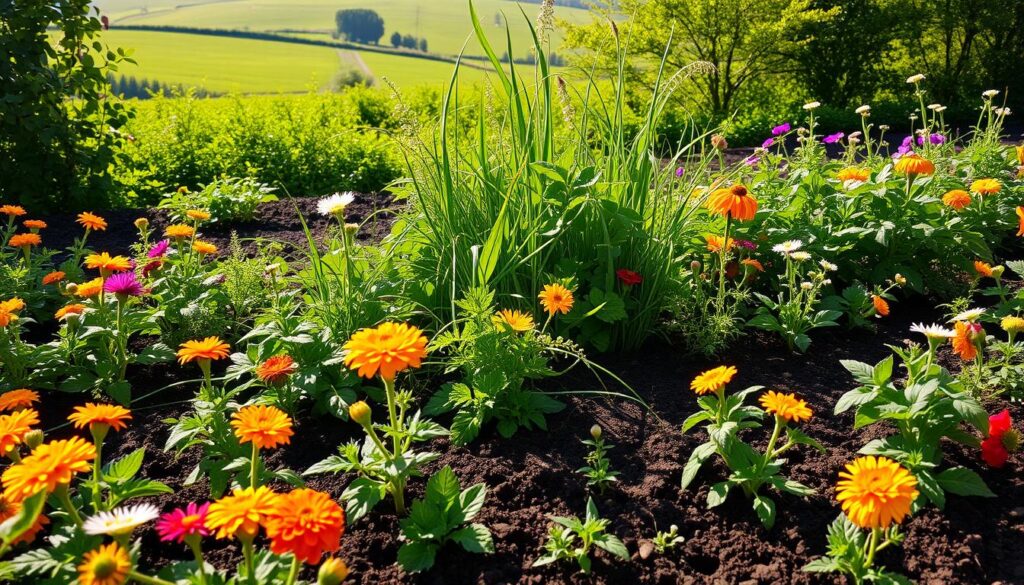
Capitalizing on Vertical Gardening
Vertical gardening with potatoes is an innovative approach that allows you to maximize your growing potential. By leveraging vertical space, you can create an environment where companion plants thrive, benefiting the overall health of your potato crop. This technique involves using trellises or other supports, offering an ideal way to boost your garden’s efficiency.
Using Vertical Space for Companion Plants
Utilizing vertical space not only saves ground space but also promotes better organization in your garden. Plants that grow vertically, such as beans or peas, can climb up supports and free up the ground for potatoes. This arrangement avoids overcrowding while enhancing the synergy among your plants. It’s essential to choose companion plants that can benefit from vertical gardening with potatoes. Consider plants like:
- Beans: They fix nitrogen in the soil, enriching nutrient availability for potatoes.
- Cucumbers: These can climb, creating a cooler microclimate that benefits potatoes.
- Peas: Their growth habit provides shade for potatoes, reducing heat exposure during the summer.
Maximizing Light and Airflow
Good airflow and light exposure are critical for healthy plant growth. By using vertical gardening with potatoes, you help ensure that sunlight reaches all your plants effectively. Proper spacing allows airflow to circulate, which reduces the risk of fungal diseases and increases photosynthesis, essential for vigorous growth. Consider adding the following elements to your vertical garden to enhance these factors:
| Element | Benefit |
|---|---|
| Trellises | Supports climbing plants, increases light exposure. |
| Plant Spacing | Prevents overcrowding, allowing for airflow. |
| Orientation | Positioning plants to maximize sunlight throughout the day. |
By embracing vertical gardening with potatoes, you can create a robust garden ecosystem that promotes healthy crops while utilizing your available space effectively.
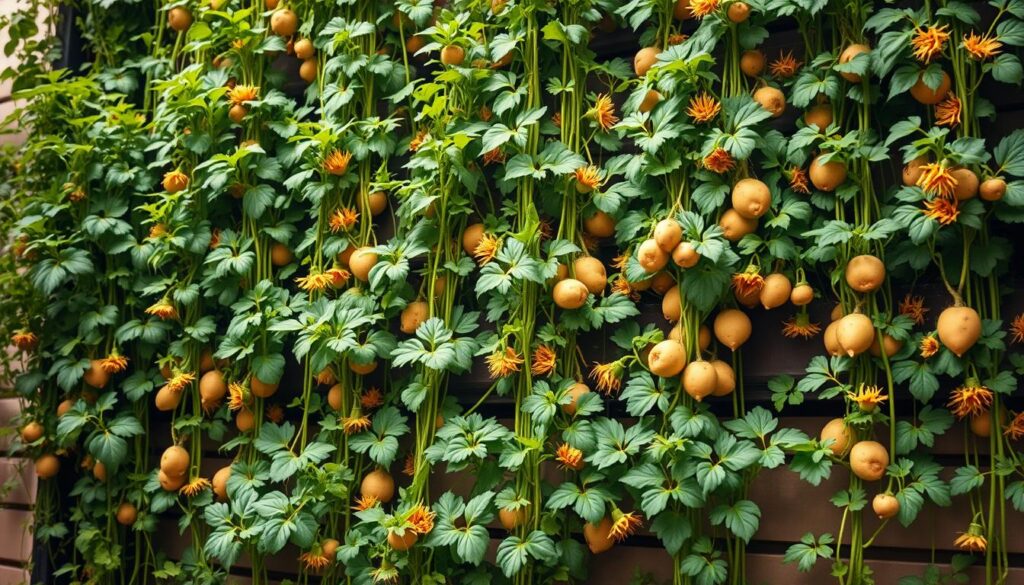
Harvest Timing and Companion Care
Understanding the perfect timing for your potato harvest significantly influences your garden yield. Potatoes usually reach maturity when the foliage turns yellow and begins to wither. Monitoring your plants for these signs is essential for effective potato harvesting tips.
Knowing When to Harvest Potatoes
Look for specific indicators that signal the right time for harvest:
- Leaves turning yellow and dying back
- Skin becoming firm, making them less prone to damage
- Size of tubers reaching your desired harvest size
Waiting too long can lead to sprouting and rot, so be attentive as the harvest time approaches.
Caring for Companion Plants Post-Harvest
After gathering your potatoes, your companion plants still require attention. Regular watering and maintenance ensure your garden remains healthy. Focus on:
- Weeding and mulching to suppress competition
- Preparing the soil for future crops
- Pruning any damaged foliage from companions
Continuing companion plant care not only benefits those plants but enhances soil health for future harvests. Your garden will thrive when you maintain this nurturing environment.
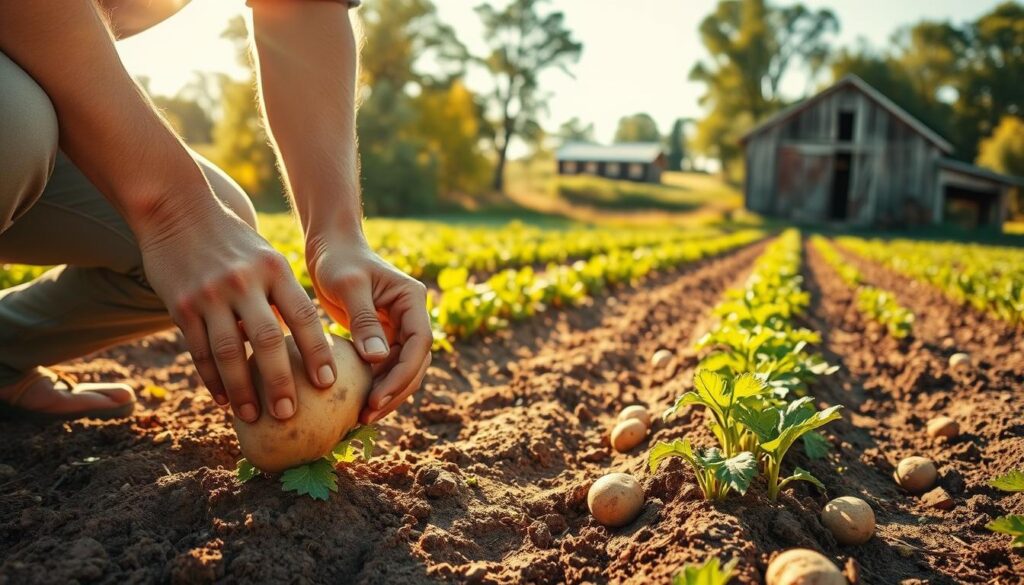
Enhancing Garden Biodiversity
Creating a rich environment in your garden significantly boosts plant health and productivity. This art of cultivating various plants together supports the overall garden biodiversity, which encourages a more resilient ecosystem. By growing a mix of companion plants, you establish a thriving community that invites beneficial insects while deterring pests.
Building a Diverse Plant Community
A diverse plant community can transform your gardening experience. Integrating various species, such as herbs, vegetables, and flowers, enables the garden to mimic natural ecosystems. This diversity allows for:
- Enhanced nutrient support among plants
- Improved soil health and structure
- Natural pest control through biological interactions
Benefits of a Balanced Ecosystem
Recognizing the benefits of biodiversity in gardening leads to more sustainable practices. Some advantages include:
- Lower risk of pest outbreaks
- Increased resilience to diseases
- Higher yields due to improved soil fertility
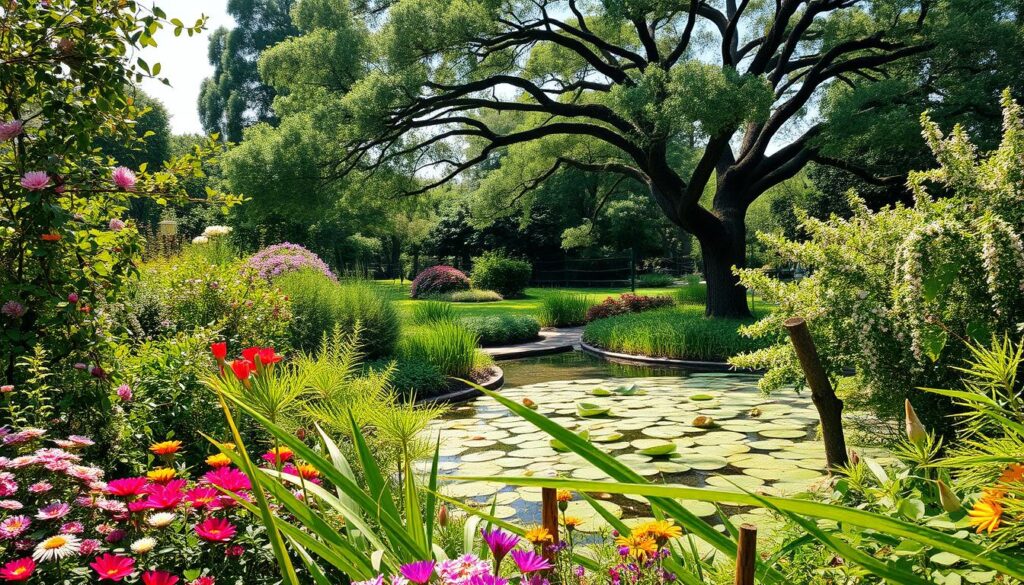
Conclusion: Enjoying a Bountiful Harvest
Embracing the art of companion planting has not only led to a richer harvest but also enriched your overall gardening experience. As you clear away your potato crops, take a moment to reflect on the fruitful combinations that thrived together. Celebrating your garden’s success is essential to fostering your passion and transforming your vegetable patch into an abundant sanctuary.
Celebrating Your Garden’s Success
Each harvest is a testament to your dedication and knowledge of the best companion plants. Take pride in knowing that your careful consideration of plant relationships has resulted in a delicious bounty. Whether it’s the robust flavor of potatoes paired with nutritious beans or the vibrant colors of marigolds enhancing the overall health of your garden, every bit of effort shows in the fruits of your labor.
Future Companion Planting Plans
As you look forward to planning for future potato gardens, consider the lessons learned from your recent growing season. Think about experimenting with different plant pairs to continue your journey of companion planting success. Incorporating new herbs, vegetables, and flowers will not only boost yield but also enhance the overall biodiversity of your ecosystem, ensuring that each future crop is even more fruitful.
